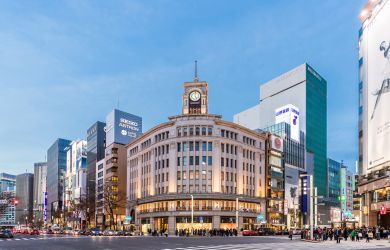
September 2, 2010
Swinging London
As the John Lennon Museum winds down, MOMA Saitama revives the '60s
By Metropolis
Originally published on metropolis.co.jp on September 2010

Blow-Up film poster, 198.8 x 140.6cm, 1966
Courtesy of Michael Whiteway

Vespa 125cc motor scooter, 100 x 153 x 77cm, 1951
Courtesy of Michael Whiteway

Velvet jacket designed by Paul Reeves & Jimmy Page, 1969
Courtesy of Jimmy Page
I used to live in the 1960s. I’m not talking about a time. I mean a place. You can still find it. All you have to do is go to St. John’s Wood in London and turn down a certain lane and there it is—Abbey Road, with its studios and zebra crossing, symbols rich with the associational magic of The Beatles. My apartment used to be right in front of the crossing, which to the frequent chagrin of local residents was ground zero for Beatles fans visiting the UK.
Saitama, where I now live, has a little of this ’60s magic as well. Since 2000, it has been home to the world’s only John Lennon Museum—quite inexplicably, as Lennon had no connection whatsoever with Tokyo’s northern suburb. But with the museum slated to close this month, time is running out even for this artificial association.
It is ironic, therefore, that the Museum of Modern Art Saitama (MOMAS), located a couple of stops from the Lennon museum, has chosen this time to host “Swinging London ’50s and ’60s,” an exhibition whose title unwittingly evokes the absurdities of Austin Powers as much as it does the glories of The Beatles or The Rolling Stones.
The exhibition takes a look at this supposedly golden decade through a selection of design and cultural goods, mainly from the ’60s but also with a few stragglers from the ’50s. Curated by Michael Whiteway, a specialist in 19th- and 20th-century British design and apparently a pal of Led Zeppelin guitarist Jimmy Page, the exhibition leans strongly towards consumer goods and The Yardbirds, the band Page was in from 1966 to 1968. We even get some of Page’s guitars and his bespoke crushed velvet suit, tailored by Paul Reeves.
There are plenty of examples of youth-oriented goods: Vespa scooters, Sony transistors, a Moulton small-wheeled bicycle. “Groovy” fashion abounds: think frock coats, parkas, pantsuits, Mary Quant dresses and billowing Zandra Rhodes fabrics—even a Lotus sports car.
There are also plenty of non-youth-oriented goods (kettles, typewriters, chairs, etc.) that add an element of the prosaic. This can’t help but undercut the more glamorous side of the ’60s represented by clips from Michelangelo Antonioni’s 1966 movie Blow-Up—the part where Page trashes his guitar—and other rock ’n’ roll mementos.
MOMAS curator Taku Shibuya contends that the ’60s established the template for a consumer youth culture which continues to flourish. “The portable radios of the time were the origin of the iPod and iPhones—a way of taking music outside,” he explains. “Also, as we can still see, girls today continue to wear the miniskirt. Many ideas that are still in use were born here.”
A missed opportunity for the exhibition is the relatively weak artistic element. A few silkscreen prints by well-known names, like Peter Blake, Richard Hamilton and Eduardo Paolozzi, complement a few uninspiring sculptures by unknown artists. More impressive are the examples of poster art—The Beatles movie Help (1965) and London-based Aussie artist Martin Sharp’s stunning psychedelic poster of Jimi Hendrix (1967), among others.
Then there are the record covers. In the era of CDs and downloads, we perhaps forget what an important medium for artistic expression album covers once were. They established such iconic images as the banana by Andy Warhol on the Velvet Underground’s debut album and the crotch clad in tight blue jeans that adorned The Rolling Stones’ Sticky Fingers LP.
While the ’60s is an increasingly distant decade, this exhibition, despite some weaknesses, manages to turn it fleetingly into a location we can visit—a bit like the John Lennon Museum, then!
Museum of Modern Art, Saitama
Swinging London, 50s-60s: Design and Culture Revolution. Until Sep 12, free (MS and under, 65 and over)/¥800 (HS)/¥1,000 (general). 9-30-1 Tokiwa, Urawa-ku, Saitama. Tel: 048-824-0111. Open Tue-Sun 10am-5:30pm, closed Mon. Nearest stn: Kita-Urawa. www.momas.jp






-390x250.jpg)
